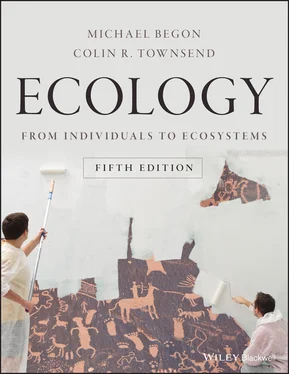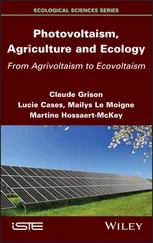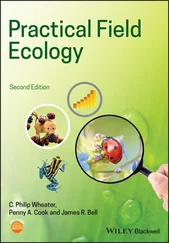
Figure 5.31 The number of (successful) territories may increase at higher resource levels.(a) The number of territories occupied by tawny owls, Strix aluco , in a study in Finland tends to increase as the abundance of their vole prey increases, though not significantly, but (b) the proportion of these in which territory holders are successful in breeding increases significantly with prey abundance ( P = 0.007).
Source : After Karell et al . (2009).
benefits and costs of territoriality
Any benefit that an individual does gain from territoriality, of course, must be set against the costs of defending the territory. In some animals this defence involves fierce combat between competitors, while in others there is a more subtle mutual recognition by competitors of one another’s keep‐out signals (e.g. song or scent). Even when the chances of physical injury are minimal, territorial animals typically expend energy in marking, patrolling and advertising their territories. Hence, for territoriality to be favoured by natural selection, we expect the benefits to exceed these costs. Indeed, we expect territories to be an optimum size – ‘as large as necessary but as small as possible’ (Kittle et al ., 2015) – in that as territory size increases, defence costs will also increase but resource access is increasingly likely to exceed the animals’ requirements. This in turn suggests that as habitat quality (and resource ‘concentration’) increases, territory sizes should decrease (they do not need to be as large), which is precisely what we see for the lion territories in Figure 5.32.
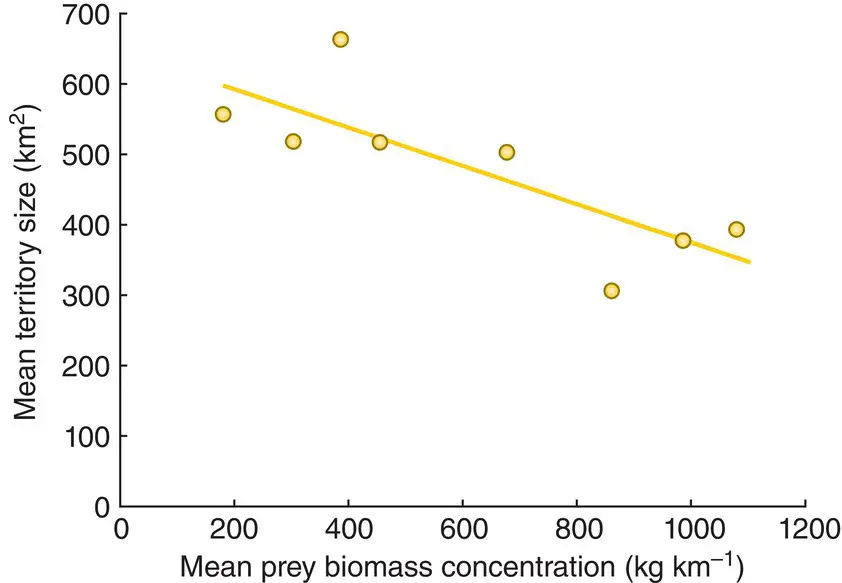
Figure 5.32 Territory sizes occupied by male lions (Panthera leo) in Zimbabwe decreased as habitat quality increased.Habitat quality was equated with the estimated concentration of the biomass of a wide range of prey species.
Source : After Loveridge et al . (2015).
floater? or territory holder?
On the other hand, explaining territoriality only in terms of a net benefit to the territory owner is rather like history always being written by the victors. A trickier question, which has received less attention, asks to what extent floaters, without a territory, are simply losers or are themselves net beneficiaries of a strategy they have adopted. Three main hypotheses, not mutually exclusive and all receiving some support, have been proposed for what determines whether an individual, as a result of a contest, becomes a floater or a territory holder: (i) territory holders are in some sense ‘stronger’, (ii) they have skills that they have acquired with age, and (iii) they are winners because they have acquired familiarity, as holders of the territory already (Sergio et al ., 2009). Variants of these hypotheses also include there being a ‘convention’, respected by the participants, through which the larger animal or the territory holder always wins. There is no doubt that some floaters are simply losers: too small, too young or too lacking in local knowledge, and therefore en route to dying without making any contribution to future generations. However, we see in Figure 5.33, for example, that for black kites, Milvus migrans , in the Doñana National Park in Spain, where floaters are neither smaller, nor in worse condition, and there is no ‘resident always wins’ rule, floaters are predominantly the youngest individuals, and territory holders are all members of the older age classes. Hence, for many of these floaters, it is not so much a case of reproduction‐denied as reproduction‐deferred. It therefore makes evolutionary sense for the young floaters to invest little in territorial contests in their earliest years (and in that sense ‘accept’ their floater status, temporarily) so as to maximise their chances of surviving long enough to win a territory later.
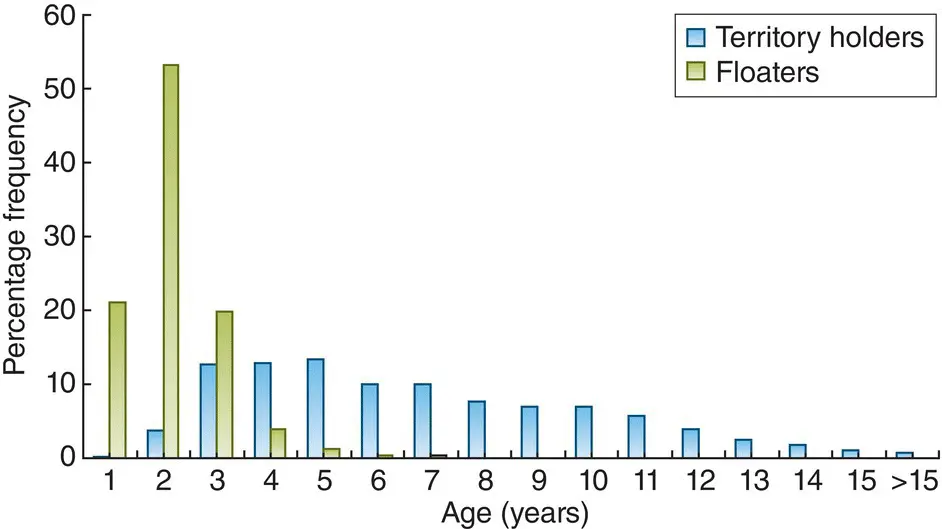
Figure 5.33 Older individuals hold the territories in a black kite population.The age profile of territory holders and non‐territory holding floaters in a black kite, Milvus migrans , population in the Doñana National Park in Spain.
Source : After Sergio et al . (2009).
dear enemies and nasty neighbours
The idea that territorial strategies will be favoured that minimise costs to the territory holders also implies that the territory holders should, where possible, tailor their level of effort to the level of threat being posed. This has led to two contrasting hypotheses. The ‘dear enemy’ hypothesis proposes that more effort should be exerted against strangers unfamiliar to the territory holder, lacking territories themselves, than against territory‐holding neighbours, since, once a territorial boundary has been established, it pays both neighbours to minimise their investment in maintaining it (Fisher, 1954). But on the other hand, the ‘nasty neighbour’ hypothesis proposes that more aggression should be displayed against neighbours than strangers, and proposes it especially for group‐living species, where out‐competing your neighbour allows your group to swell in size (Temeles, 1994). There is evidence for both ( Figure 5.34), and while the dear enemy effect seen for the rodents in Figure 5.34a appears to be the more common, the nasty neighbour effect does indeed appear to be most often found in group‐living species, such as the ants in Figure 5.34b.
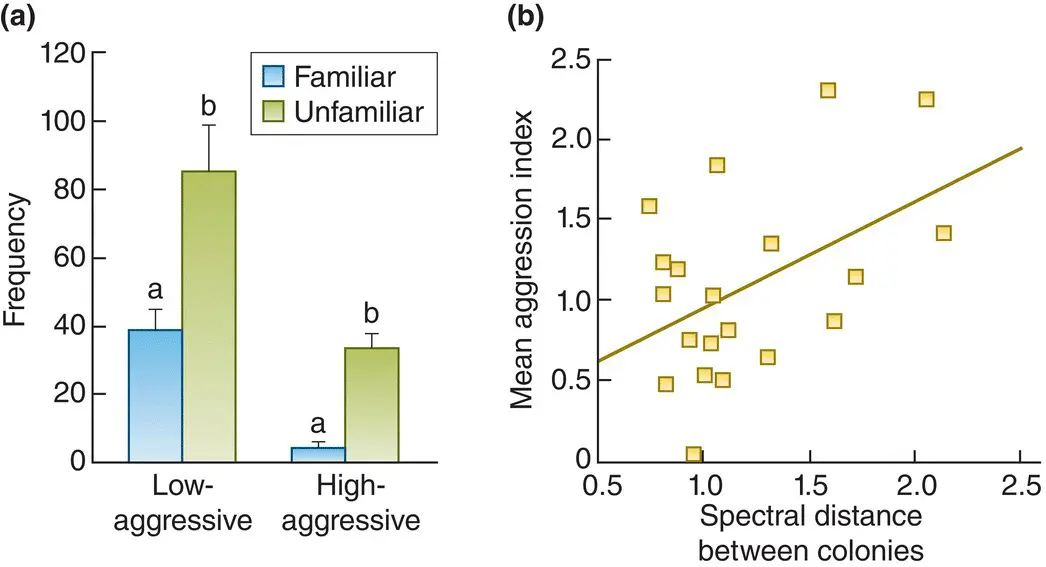
Figure 5.34 ‘Dear enemy’ and ‘nasty neighbour’ effects.(a) Male subterranean rodents, Ctenomys talarum (tuco‐tucos) in Argentina display more aggressive (especially high‐aggressive) behaviour towards unfamiliar than towards familiar opponents in staged contest. Familiarity was gained by previously exposing contestants to the odour of their opponents. In the ‘unfamiliar’ treatment, exposure was to an odour of an animal other than the opponent. Bars are SEs; different letters denote significant differences ( P < 0.05). (b) Weaver ant colonies, Oecophylla smaragdina , in Queensland, Australia, behaved more aggressively towards other colonies the less related they were to them in terms of the chemicals in their cuticle (less related = greater ‘spectral distance’).
Source : (a) After Zenuto (2010). (b) After Newey et al . (2010).
APPLICATION 5.3 Reintroduction of territorial vultures
Having seen that many species compete for territories related to the availability of resources rather than for the resources themselves, it is perhaps not surprising that when we come to manage such species, ensuring the availability of territories is a top priority. A good example comes from a study of bearded vultures, Gypaetus barbatus , which became extinct in the European Alps more than a century ago, and have been the focus of a reintroduction programme since 1986 ( Figure 5.35). Captive‐reared individuals were released from four widely dispersed sites from which they spread to new areas, and this spread was monitored in the Valais region of Switzerland (not one of the release sites). During an initial phase, from 1987 to 1994, the sightings were of subadults, and the most important factor explaining the distribution of these sightings was the biomass of ibex, Capra ibex , whose carcasses are an important resource for the vultures. However, during the subsequent phase, from 1995 to 2001, when adults were finally settling in the region, the presence of the vultures was most closely correlated with the distribution of craggy limestone crags, which are the ideal base for their territories, providing nest sites, thermal conditions for soaring, and limestone screes for bone breaking and food storage. Food availability was of only secondary significance. It seems clear, therefore, that future reintroductions in the area should focus precisely on the availability of these viable territories.
Читать дальше
